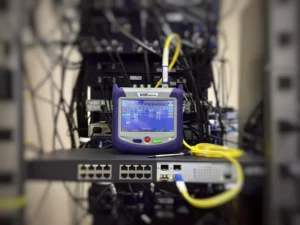In the vast and ever-expanding landscape of computing, where data flows ceaselessly and digital demands soar to new heights, there emerges a transformative force known as utility computing. Like a masterful conductor orchestrating a symphony of technological resources, utility computing presents itself as the maestro of efficiency, the virtuoso of cost optimization, and the conductor of on-demand services.
With its ability to seamlessly allocate computing resources, manage infrastructure, and deliver technical prowess at the precise moment of need, utility computing is rewriting the rules of the digital realm. Step into the realm of utility computing, where the mundane is automated, the resources are dynamic, and the possibilities are boundless.
Prepare to immerse yourself in a world where computing power becomes a consumable utility, where organizations can scale with ease, and where innovation and cost-effectiveness harmoniously coexist. Welcome to the symphony of utility computing, where technology and business align in perfect rhythm.
What is utility computing?
Utility computing is a service provisioning paradigm in which a service provider offers customers access to computing resources, infrastructure management, and technical services on an as-needed basis. In contrast to a fixed-rate fee structure, the provider determines charges based on the actual quantity of services utilized by the customer. Similar to other forms of on-demand computing, such as grid computing, the utility model aims to optimize resource utilization, reduce costs, or achieve both objectives concurrently.
The term “utility” is employed as an analogy to draw parallels with services like electrical power that aim to meet variable customer demand and apply charges based on resource consumption. This approach, often referred to as pay-per-use or metered services, is gaining popularity in enterprise computing and is occasionally extended to consumers for services such as internet connectivity, website access, file sharing, and other applications.

Within the enterprise, another variant of utility computing is the shared pool utility model. Under this framework, the organization consolidates its computing power and resources to cater to a substantial user base, thereby minimizing redundant systems and infrastructure. This centralized approach enables efficient resource allocation and enhances cost-effectiveness within the enterprise ecosystem.
Computational resources
Computation time, also known as CPU time, represents the primary resource in addition to memory usage within the realm of computer resources. These resources encompass not only physical equipment but also extend to files, network connections, virtual memory space, and other pertinent elements. Some notable computer resources include:
- Processing capacity: Refers to the duration of computing operations performed by the central processing unit (CPU).
- Memory allocation: Encompasses the utilization of physical RAM as well as virtual memory space allocated by the operating system.
- File storage: Pertains to the storage capacity and speed of accessing data on the hard drive.
- Bandwidth utilization: Signifies the maximum data transfer rate across a network connection.
- System environment resources: Represents variables that influence the behavior and settings of a computing environment.
These aforementioned elements collectively constitute vital computer resources in various computational environments.
Characteristics of utility computing
Utility computing encompasses a wide range of definitions, but typically entails the presence of five key characteristics. These characteristics are commonly associated with utility computing and serve as foundational elements for its conceptual framework.
10 edge computing innovators to keep an eye on in 2023
Scalability
In the realm of utility computing, it is crucial to ensure the availability of adequate IT resources under all circumstances. This entails guaranteeing that increasing demand for a service does not compromise its quality, such as response time. Maintaining consistent service quality even in the face of heightened demand is a critical objective in utility computing.
Standardized services
The utility computing service provider provides customers with a catalog of standardized services, each accompanied by specific service level agreements (SLAs) that define the quality and pricing of the IT services. In this context, customers do not have control over the underlying technologies employed, such as the server platform. The service offerings are pre-defined by the provider, and customers must select from the available options without the ability to influence the underlying technological aspects.

Demand pricing
Traditionally, companies have been required to purchase their own hardware and software in order to obtain computing power. This entails upfront payment for the IT infrastructure, irrespective of how extensively the company ends up utilizing it later on. In order to address this, technology vendors have implemented strategies such as tying server leasing rates to the number of CPUs enabled for the customer. This enables companies to measure the computing power utilized by individual departments, thereby allowing IT costs to be directly allocated to specific organizational units. Alternative methods of linking IT costs to usage are also feasible.
Automation
Repetitive management tasks, such as server setup and updates installation, can be automated to streamline operations. Furthermore, automation allows for the efficient allocation of resources to services and optimization of IT service management. Considerations must be given to service level agreements (SLAs) and operational costs associated with IT resources. By automating these tasks and aligning them with SLAs and cost considerations, organizations can enhance operational efficiency and resource utilization.
AI computers are redefining how we think about computing
Virtualization
Virtualization technologies are utilized to enable resource sharing, including web and other resources, within a shared pool of machines. This approach involves dividing the network into logical resources rather than relying solely on physical resources. In this setup, applications are not assigned to specific predetermined servers or storage. Instead, they are dynamically allocated server runtime or memory from the available pool of resources as needed. This flexible allocation ensures efficient utilization of resources within the shared environment.
What are the types of utility computing?
Utility computing can be categorized into two types: internal utility and external utility. Internal utility refers to a computer network that is shared exclusively within a company, enabling efficient resource utilization among various departments or divisions within the organization. On the other hand, external utility involves multiple computer companies coming together to pool their resources and services under the management of a dedicated service provider. This collaborative approach allows organizations to leverage external resources and expertise to meet their computing needs. Additionally, hybrid forms of utility computing are also possible, combining elements of both internal and external utility to create customized solutions that best suit specific requirements.
Benefits of utility computing
Utility computing presents substantial cost reduction opportunities for IT departments by facilitating the efficient utilization of existing resources. With utility computing, companies can optimize their resource allocation, ensuring that computing power and infrastructure are allocated precisely where and when they are needed. As a result, costs associated with IT infrastructure and services can be accurately allocated to specific departments within the organization, enhancing cost transparency and facilitating better financial management.
One of the key benefits of utility computing is its ability to enhance flexibility and agility within organizations. IT resources can be dynamically allocated and scaled up or down in response to fluctuating demand, ensuring that businesses can swiftly adapt to changing requirements. This agility enables organizations to seize new opportunities, respond promptly to market shifts, and efficiently manage their IT capabilities.

Furthermore, utility computing streamlines IT management processes by reducing the need for individualized infrastructure for each application. Instead of maintaining separate systems and resources for different applications or departments, utility computing provides a centralized and shared pool of resources that can be efficiently allocated as needed. This consolidation simplifies IT management, reducing complexity, and improving operational efficiency.
The benefits of utility computing can be summarized as follows:
- Cost reduction:
- Efficient utilization of existing resources.
- Transparent cost allocation to specific departments.
- Reduced personnel requirements for operational tasks.
- Flexibility and agility:
- Dynamic allocation and scaling of IT resources.
- Quick adaptability to fluctuating demand and changing business needs.
- Prompt response to new opportunities and market shifts.
- Streamlined IT management:
- Centralized and shared resource pool.
- Reduced complexity through consolidated infrastructure.
- Improved operational efficiency.
These benefits collectively contribute to increased cost-effectiveness, enhanced operational agility, and improved IT management processes for organizations embracing utility computing.
Utility computing vs grid computing
- Grid computing, as its name implies, is a computing paradigm that leverages resources from diverse administrative domains to accomplish a shared objective. Its primary objective is to virtualize resources in order to efficiently address problems or challenges, harnessing the collective computing power of multiple networked computers simultaneously to solve technical or scientific issues.
- Utility computing, as its name suggests, is a computing model that offers services and computing resources to customers. It essentially provides users with an on-demand facility where they can access and utilize specific computing resources, for which they are charged accordingly. It shares similarities with cloud computing and therefore necessitates a cloud-like infrastructure to deliver its services effectively.
While it is true that both grid computing and utility computing paved the way for cloud computing, they can now be seen as earlier implementations of the broader cloud computing paradigm. Cloud computing encompasses all the functionalities and capabilities of grid computing and utility computing, and expands upon them significantly.
Cloud computing surpasses the limitations of specific networks by leveraging the vast Internet as its platform, making it accessible from anywhere. It offers a more comprehensive virtualization of resources, resulting in heightened scalability and reliability. These advantages are more pronounced in cloud computing, allowing for dynamic allocation of resources and efficient scaling of applications as per demand.

It is important to note that utility computing can be implemented independently of cloud computing. For instance, a scenario where a supercomputer leases processing time to multiple clients exemplifies utility computing, where users are charged based on the resources they consume. However, since this setup operates from a single physical location without resource virtualization, it does not meet the criteria to be classified as cloud computing.
On the other hand, grid computing can be viewed as a less advanced form of cloud computing, as it typically involves some level of resource virtualization. Nevertheless, grid computing is considered weaker than cloud computing due to certain limitations. One notable distinction is the potential risk of a grid failure resulting from the failure of a critical location, which may have greater significance than other locations. In contrast, cloud computing incorporates redundancy and distributed infrastructure, enabling effective management of such situations.
Exploring the hidden web of distributed computing
Grid computing can be considered a less advanced version of cloud computing, lacking many of the advantages and benefits offered by the latter. On the other hand, utility computing can be seen more as a business model rather than a specific technology. While cloud computing can support utility computing, it’s important to note that not all forms of utility computing are necessarily based on the cloud.
| Grid Computing | Utility Computing | |
| Resource Sharing | Shares computing resources from multiple administrative domains | Shares computing resources within a single organization or among multiple organizations |
| Virtualization | May involve partial virtualization of resources | May or may not involve resource virtualization |
| Scalability | Limited scalability due to potential dependence on specific locations | Offers greater scalability and elasticity to adapt to changing demands |
| Redundancy | Relies on redundancy across multiple locations to mitigate failures | Redundancy may vary based on implementation, but typically less robust than cloud computing |
| Management | More complex management and coordination among distributed resources | Simplified management with centralized control and allocation of resources |
| Use cases | Scientific research, large-scale data analysis, high-performance computing | Enterprise IT infrastructure, pay-per-use services, resource optimization |
Key takeaways
- Utility computing offers on-demand access to computing resources and services, charging users based on actual usage.
- It aims to optimize resource utilization and reduce costs, similar to other on-demand computing models.
- Utility computing can be implemented internally within an organization or through external service providers.
- Computational resources include CPU time, memory utilization, storage, network bandwidth, and system environment variables.
- Utility computing emphasizes standardized services with specific service level agreements (SLAs) defined by the provider.
- Automation plays a key role in optimizing resource allocation and IT service management.
- Grid computing is a precursor to cloud computing, while utility computing is a business model that can be supported by cloud computing, but not exclusively based on it.

Bottom line
Utility computing stands as a transformative force within the realm of modern computing. By providing on-demand access to computing resources and services, it revolutionizes the way organizations manage their IT infrastructure and optimize resource utilization. With its standardized services, transparent cost structures, and dynamic allocation of resources, utility computing presents a compelling solution for businesses seeking flexibility, scalability, and cost-effectiveness.
Through the orchestration of computing resources, utility computing eliminates the need for upfront investments in hardware and software, enabling organizations to adapt swiftly to changing demands without incurring unnecessary expenses. It empowers businesses to focus on their core competencies while entrusting the management of IT resources to specialized providers.
- SEO Powered Content & PR Distribution. Get Amplified Today.
- PlatoAiStream. Web3 Data Intelligence. Knowledge Amplified. Access Here.
- Minting the Future w Adryenn Ashley. Access Here.
- Buy and Sell Shares in PRE-IPO Companies with PREIPO®. Access Here.
- Source: https://dataconomy.com/2023/05/15/what-is-utility-computing/
- :is
- :not
- :where
- $UP
- 1
- 14
- 250
- 8
- a
- ability
- About
- access
- accessible
- accessing
- accompanied
- accomplish
- accordingly
- accurately
- Achieve
- across
- actual
- adapt
- addition
- Additionally
- address
- administrative
- advanced
- advantages
- agreements
- AI
- aim
- aims
- align
- All
- allocated
- allocation
- Allowing
- allows
- also
- alternative
- among
- an
- analysis
- and
- and infrastructure
- Another
- anywhere
- Application
- applications
- Apply
- approach
- ARE
- AS
- aspects
- assigned
- associated
- At
- Automated
- automating
- Automation
- availability
- available
- Bandwidth
- base
- based
- basis
- BE
- becomes
- been
- benefits
- BEST
- Better
- both
- Boundless
- broader
- business
- business model
- businesses
- but
- by
- CAN
- capabilities
- Capacity
- catalog
- cater
- central
- centralized
- certain
- challenges
- changing
- characteristics
- charged
- charges
- charging
- circumstances
- classified
- clients
- Cloud
- cloud computing
- collaborative
- Collective
- collectively
- combining
- coming
- commonly
- Companies
- company
- compelling
- complex
- complexity
- comprehensive
- compromise
- computer
- computers
- computing
- computing power
- conceptual
- conductor
- connection
- Connections
- Connectivity
- considerations
- considered
- consistent
- Consolidates
- consolidation
- constitute
- consume
- Consumers
- consumption
- content
- context
- contrast
- contribute
- control
- coordination
- Core
- Cost
- cost reduction
- Costs
- CPU
- create
- criteria
- critical
- crucial
- customer
- Customers
- customized
- data
- data analysis
- dedicated
- defined
- deliver
- Demand
- demands
- departments
- dependence
- determines
- different
- digital
- directly
- distributed
- diverse
- do
- does
- domains
- down
- draw
- drive
- due
- duration
- dynamic
- dynamically
- each
- Earlier
- ease
- ecosystem
- Edge
- edge computing
- Effective
- effectively
- efficiency
- efficient
- efficiently
- elements
- eliminates
- embracing
- emerges
- emphasizes
- employed
- empowers
- enable
- enabled
- enables
- enabling
- encompass
- encompasses
- end
- ends
- enhance
- enhanced
- Enhances
- enhancing
- ensure
- ensures
- ensuring
- Enterprise
- Environment
- environments
- equipment
- essentially
- Even
- exclusively
- exemplifies
- existing
- expands
- expenses
- expertise
- extend
- external
- eye
- Face
- facilitating
- Facility
- Failure
- feasible
- fee
- File
- Files
- financial
- financial management
- Flexibility
- flexible
- Flows
- Focus
- follows
- For
- Force
- form
- forms
- Framework
- from
- functionalities
- Furthermore
- gaining
- given
- greater
- Grid
- hand
- Hard
- hard drive
- Hardware
- Harnessing
- Have
- heightened
- heights
- Hidden
- high-performance
- How
- However
- HTTPS
- Hybrid
- Immerse
- implementation
- implemented
- important
- improved
- improving
- in
- include
- Including
- incorporates
- increased
- increasing
- independently
- individual
- influence
- Infrastructure
- Innovation
- innovators
- installation
- instance
- instead
- internal
- internally
- Internet
- into
- Introduction
- Investments
- involve
- irrespective
- issues
- IT
- IT Management
- IT service
- ITS
- itself
- jpg
- Keep
- Key
- known
- landscape
- large-scale
- later
- leasing
- less
- Level
- Leverage
- leverages
- leveraging
- like
- limitations
- linking
- location
- locations
- logical
- Machines
- Maestro
- Making
- manage
- management
- many
- Market
- max-width
- maximum
- May..
- measure
- Meet
- Memory
- methods
- minimizing
- Mitigate
- model
- models
- Modern
- moment
- more
- multiple
- must
- name
- necessarily
- Need
- needed
- needs
- network
- networks
- Nevertheless
- New
- notable
- now
- number
- objective
- objectives
- obtain
- of
- offered
- Offerings
- Offers
- often
- on
- On-Demand
- on-demand services
- ONE
- only
- operates
- operating
- operating system
- operational
- Operations
- opportunities
- optimization
- Optimize
- optimizing
- Options
- or
- orchestration
- order
- organization
- organizational
- organizations
- Other
- over
- own
- paradigm
- Parallels
- payment
- perfect
- Personnel
- physical
- platform
- plato
- Plato Data Intelligence
- PlatoData
- plays
- pool
- popularity
- possibilities
- possible
- potential
- power
- precise
- precisely
- precursor
- presence
- presents
- pricing
- primary
- problems
- processes
- processing
- provider
- providers
- provides
- providing
- prowess
- purchase
- quality
- quantity
- RAM
- range
- Rate
- Rates
- rather
- realm
- Redefining
- reduce
- reducing
- reduction
- referred
- refers
- reliability
- represents
- required
- Requirements
- research
- resource
- resource utilization
- Resources
- Respond
- response
- result
- resulting
- revolutionizes
- rewriting
- Risk
- robust
- Role
- rules
- Scalability
- Scale
- scaling
- scenario
- seamlessly
- seeking
- seen
- Seize
- separate
- serve
- service
- Service Provider
- service providers
- Services
- settings
- setup
- shared
- Shares
- sharing
- Shifts
- significance
- significantly
- signifies
- similar
- similarities
- simultaneously
- since
- single
- situations
- Software
- solution
- Solutions
- SOLVE
- some
- Space
- specialized
- specific
- speed
- stands
- Step
- storage
- strategies
- streamline
- structure
- substantial
- such
- Suggests
- Suit
- supercomputer
- support
- Supported
- system
- Systems
- tasks
- Technical
- technological
- Technologies
- Technology
- than
- that
- The
- their
- Them
- There.
- thereby
- therefore
- These
- they
- think
- this
- Through
- time
- to
- together
- transfer
- transformative
- Transparency
- transparent
- true
- two
- types
- typically
- under
- underlying
- unit
- units
- Updates
- upon
- Usage
- User
- users
- utility
- utilize
- utilized
- Utilizing
- Variant
- various
- Vast
- vendors
- version
- Virtual
- vital
- vs
- Way..
- we
- web
- Website
- welcome
- WELL
- What
- What is
- when
- which
- while
- wide
- Wide range
- Wikipedia
- with
- within
- without
- world
- yourself
- zephyrnet











